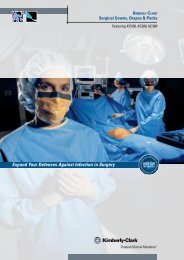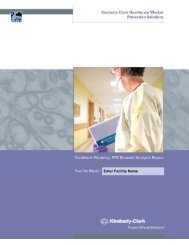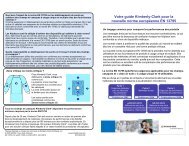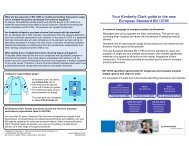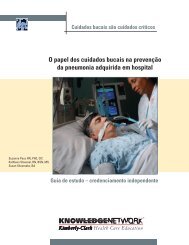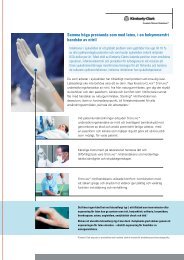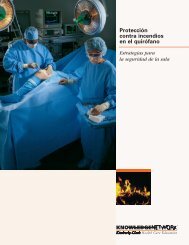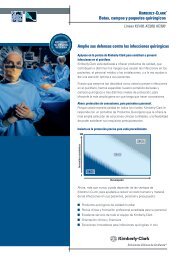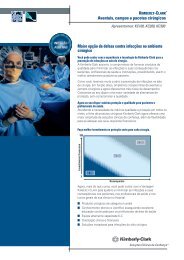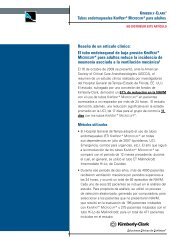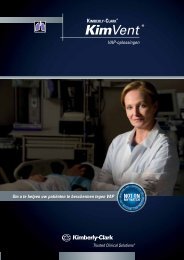Wet Pack Troubleshooting Guide - Digestive Health
Wet Pack Troubleshooting Guide - Digestive Health
Wet Pack Troubleshooting Guide - Digestive Health
You also want an ePaper? Increase the reach of your titles
YUMPU automatically turns print PDFs into web optimized ePapers that Google loves.
KIMBERLY-CLARK* KIMGUARD*<br />
Sterilization Wrap<br />
CONFIDENTIAL<br />
For K-C Representatives Only<br />
<strong>Wet</strong> <strong>Pack</strong> <strong>Troubleshooting</strong> <strong>Guide</strong>
TABLE OF<br />
CONTENTS<br />
■<br />
Process Overview<br />
■<br />
Inner <strong>Wet</strong>ness<br />
■<br />
Outer <strong>Wet</strong>ness<br />
■<br />
Short-Term Solutions<br />
■<br />
Reference
COVER<br />
LETTER<br />
Dear <strong>Health</strong> Care Sales Representative:<br />
This <strong>Wet</strong> <strong>Pack</strong> Program is provided to you in<br />
a format that positions you as the expert in<br />
solving wet pack problems. This program is<br />
intended for Sales Representative use only. It is<br />
not intended to be given to the customer.<br />
■ The format covers:<br />
1) Five questions to ask regarding<br />
inner wetness.<br />
2) Five questions to ask regarding<br />
outer wetness.<br />
The following section (Short-Term Solutions)<br />
covers “band-aid,” or short-term, actions the<br />
customer can take to get sterilized items to the<br />
O.R. until the problem is resolved.<br />
■ Don’t forget, KIMBERLY-CLARK* wrap<br />
does not cause wet pack problems.<br />
<strong>Wet</strong> packs are caused by any number<br />
of the following:<br />
1) Steam Quality<br />
2) Sterilizer Function<br />
3) Loading Techniques<br />
In the July 1984 issue of Laundry News, Jim<br />
Hickey of American Hospital Company (formally<br />
American Hospitex) stated that “there<br />
can be a 20% moisture content in cotton<br />
before it feels wet.”<br />
In the Reference Section, we have included<br />
diagrams of Steam Sterilization Systems and<br />
Loading Techniques.<br />
Please review these, and begin familiarizing<br />
yourself with the process overview. Then, take<br />
the customer through the program format.<br />
Remember to make clear to the hospital that<br />
information about “wet packs” provided by<br />
K-C, whether in writing or verbally, is NOT<br />
TO BE CONSIDERED BY THE HOSPITAL<br />
AS ADVICE TO TAKE ANY PARTICULAR<br />
ACTION. The hospital should conduct<br />
its own analysis and determine what action<br />
is appropriate.<br />
IMPORTANT INFORMATION REGARD-<br />
ING PERSONAL SAFETY. In conducting<br />
this program, please keep in mind that you<br />
should take all usual precautions for your<br />
safety in the hospital. You can give all of the<br />
information in this guide to the hospital<br />
WITHOUT having to enter any areas of the<br />
hospital where you are not authorized to be<br />
present, or where you normally would not be<br />
present in the course of your sales activities.<br />
Remember, WHEN IN DOUBT, STAY OUT.<br />
■ One sterilizer manufacturer stated:<br />
“The occurrence of water droplets<br />
has increased significantly with the<br />
increased use of water-repellent wraps.<br />
Although these wraps do not create the<br />
droplets (unlike 140-thread-muslin<br />
which absorbs and disperses steam<br />
condensate that may fall on the wrap<br />
surface), they do retain them as droplets<br />
of moisture.” 1<br />
1<br />
Edna Kirkland, RN, “<strong>Guide</strong>lines for Preparing and Sterilizing Wrapped<br />
<strong>Pack</strong>s,” in AMSCO Technical Manual, eds. Karle and Ryan, (American<br />
Sterilizer Co, 1983), pp. 2-4.<br />
1
PROCESS<br />
OVERVIEW<br />
■ Step-by-Step Instructions for Handling a <strong>Wet</strong> <strong>Pack</strong> Problem.<br />
1<br />
Make an appointment with the<br />
customer to discuss the problem. If<br />
you are unable to meet face-to-face,<br />
explain the problem-solving process<br />
over the phone.<br />
2<br />
Begin the process by allowing the<br />
customer to tell you all they know<br />
about the problem. This will allow<br />
the customer to vent any frustrations<br />
or complaints about the situation and<br />
allow you to gain customer insight<br />
and information.<br />
3<br />
Gain credibility with the customer<br />
by letting the customer know that<br />
based upon 20 years of experience,<br />
Kimberly-Clark can offer assistance<br />
with wet pack problems, including<br />
working with an independent<br />
outside source.<br />
4<br />
After taking the customer through<br />
the program, follow-up with<br />
calls to the customer to help<br />
ensure resolution.<br />
2
INNER<br />
WETNESS<br />
■ Gather specific information by asking the following questions:<br />
A. Are you seeing the wetness on the inside<br />
of the package? If yes, then…<br />
■<br />
3. What is the dry cycle temperature half<br />
way into the dry cycle?<br />
■<br />
■<br />
1. Have the traps directly behind the<br />
sterilizer been checked to ensure the<br />
traps are working properly?<br />
RATIONALE: If the trap is running<br />
“hot”, it could be stuck open. If the<br />
trap is stuck open, steam could be<br />
escaping out of the trap resulting in<br />
steam pressure loss.<br />
ACTION REQUIRED: Ask the<br />
hospital engineer to assess whether<br />
the traps behind the sterilizer are<br />
working properly.<br />
2. Is the vacuum pull during the dry cycle<br />
26 Hg (inches of mercury) or greater?<br />
RATIONALE: A good vacuum pulls<br />
out excess condensate that remains in<br />
the load when the drying cycle begins.<br />
The maximum possible vacuum is<br />
30 Hg.<br />
ACTION REQUIRED: Ask the<br />
hospital engineer to monitor the<br />
vacuum reading during the sterilizer<br />
dry cycle. If the vacuum falls below<br />
26 Hg, take action to increase the<br />
vacuum. The most common way to<br />
increase the vacuum is to increase the<br />
“water ejector pressure” that causes<br />
the vacuum phenomenon.<br />
RATIONALE: During the dry cycle,<br />
a vacuum is pulling steam and residual<br />
air from the chamber. After about<br />
10 minutes into the dry cycle, the<br />
temperature in the chamber should<br />
drop below 205° F. This drop in<br />
temperature is a phenomenon that<br />
occurs when the chamber experiences<br />
negative pressure due to the vacuum.<br />
A temperature above 205° F after<br />
10 minutes into the dry cycle indicates<br />
a solenoid valve leak above the steam<br />
inlet. Such a leak can draw steam<br />
(moisture) back into the sterilizer<br />
chamber during drying, causing<br />
wet packs.<br />
ACTION REQUIRED: Ask hospital<br />
personnel to read the chamber<br />
temperature in the sterilizer 10<br />
minutes into the dry cycle. If the<br />
temperature exceeds 205° F, ask the<br />
sterilizer manufacturer maintenance<br />
representative or the hospital sterilizer<br />
maintenance employee to explain the<br />
high temperature. The high temperature<br />
is a direct indication that the<br />
solenoid valve above the steam inlet is<br />
opening up and leaking steam during<br />
the dry cycle.<br />
3
INNER WETNESS<br />
(continued)<br />
■<br />
■<br />
4. Is the steam inlet pressure adequate in<br />
the steam line prior to the point where<br />
steam enters the sterilizer?<br />
RATIONALE: Steam is generated at a<br />
boiler under high pressure, then as the<br />
steam travels through the line (pipes),<br />
the pressure is stepped down, usually<br />
in the middle of the line, then at the<br />
sterilizer. If the pressure in the middle<br />
of the line is at 60 pounds per square<br />
inch gauge (psig), and the pressure<br />
delivered at the sterilizer is at 30 psig,<br />
the pressure difference would be 30<br />
psig, (i.e., 60 psig- 30 psig = 30 psig).<br />
The bigger the pressure difference,<br />
the better the evaporation of water<br />
droplets in the chamber during the<br />
sterilization process. (The sterilizer<br />
manufacturer typically presets this setting<br />
between 30-35 psig.)<br />
ACTION REQUIRED: The hospital<br />
engineer should provide the steam<br />
pressure reading in the steam line<br />
prior to the point where steam enters<br />
the sterilizer. The reading should be<br />
60-80 psig.<br />
5. Is wetness isolated only in basin sets?<br />
RATIONALE: Basin sets are the main<br />
culprit when it comes to loading problems<br />
that cause wetness. The potential<br />
for wetness to occur is high because<br />
there are so many items in the basin<br />
that can trap water, such as emesis<br />
pans, bowls, and medicine cups.<br />
ACTION REQUIRED: If wetness is<br />
primarily in basin sets, Central<br />
Service/SPD staff should check the<br />
positioning of items inside the basin.<br />
To make sure basins are loaded properly,<br />
perform a test using an unwrapped<br />
basin set. Take the unwrapped basin<br />
set to a sink. Run water over the items<br />
in the basin. With the assistance of a<br />
Central Service/SPD employee, tilt<br />
the basin as it would be positioned if<br />
it were in the sterilizer. Notice how the<br />
water drains off the basin contents.<br />
Does any pooled water remain inside<br />
or outside the basin set? If pooled<br />
water remains, there are two options<br />
for solving the problem:<br />
a. Reposition the item where pooled<br />
water is noted so water drains off the<br />
item when tilted above the sink.<br />
b. If the item cannot be repositioned<br />
(i.e., the “lip” on the outer rim of the<br />
basin), add an absorbent towel to wick<br />
away pooled water.<br />
Make sure there are no un-anchored<br />
items (like medicine cups) which may<br />
tip back upwards when the basin set is<br />
loaded, and then tip over, spilling<br />
water into the set when the set is<br />
unloaded.<br />
4
OUTER<br />
WETNESS<br />
■ Gather specific information by asking the following questions:<br />
B. Are you seeing the wetness on the outside<br />
of the package? If yes, then …<br />
■<br />
■<br />
1. Have the traps directly behind the<br />
sterilizer been checked to ensure the<br />
traps are working properly?<br />
RATIONALE: If the trap is running<br />
“cold”, it could be stuck closed. If the<br />
trap is stuck closed, excess water<br />
gathering along the inside of the pipes<br />
could fill the trap, so the excess water<br />
in the trap would have no place to<br />
evacuate. Since the trap would be<br />
filled with water, the result is water<br />
flowing out of the trap and pouring<br />
into the sterilizer, causing water to<br />
“rain” on the outside of the packages.<br />
ACTION REQUIRED: Ask the<br />
hospital engineer to assess whether<br />
the traps behind the sterilizer are<br />
working properly.<br />
2. Is the vacuum pull during the dry cycle<br />
26 Hg (inches of mercury) or greater?<br />
RATIONALE: A good vacuum pulls<br />
out excess condensate that remains in<br />
the load when the drying cycle begins.<br />
The maximum possible vacuum is 30<br />
Hg.<br />
ACTION REQUIRED: Ask the<br />
hospital engineer to monitor the<br />
vacuum reading during the sterilizer<br />
dry cycle. If the vacuum falls below<br />
26 Hg, take action to increase the<br />
■<br />
■<br />
vacuum. The common way to increase<br />
the vacuum is to increase the “water<br />
ejector pressure” that causes the<br />
vacuum phenomenon.<br />
3. Is the “check valve” below the sterilizer<br />
chamber working properly? Is there<br />
even a “check valve” installed below<br />
the drain?<br />
RATIONALE: A “check valve”<br />
installed below the chamber drain<br />
helps prevent an upspray of<br />
water from the drain during the<br />
sterilization cycle.<br />
ACTION REQUIRED: Especially<br />
if water is present on the lower<br />
portion of the load, ask the sterilizer<br />
maintenance person to verify function<br />
of the check valve.<br />
4. Is the sterilizer shelving unit a cause of<br />
outer wetness?<br />
RATIONALE: Sometimes moisture<br />
droplets on the outside of the package<br />
follow the outline of the sterilizer<br />
shelving unit configuration. This type<br />
of outer wetness is due to one of the<br />
following:<br />
(1) Excess air in the chamber cools the<br />
metal shelving unit and causes moisture<br />
droplets to form on the shelving unit.<br />
This excess air in the chamber usually<br />
occurs in all linen loads where air pockets<br />
exist between the stacks of cloth. The air<br />
5
OUTER WETNESS<br />
(continued)<br />
creates a cooling effect on the metal<br />
shelving unit, causing condensate to<br />
form.<br />
(2) The shelving unit has been<br />
designed in a configuration that traps<br />
water so that when the shelving unit is<br />
removed from the sterilizer, the water<br />
splashes onto the packages below.<br />
ACTION REQUIRED: (1) Discuss<br />
extending the drying time on linen<br />
loads only, and (2) ask the hospital<br />
engineer/sterilizer representative<br />
whether or not it would be a good idea<br />
to “bend down” the metal on the<br />
shelving unit where water is getting<br />
trapped, or to drill holes in the problem<br />
area if rust formation on the shelving<br />
unit is not a concern.<br />
■<br />
5. Has the hospital engineer evaluated<br />
the design of the steam line to look<br />
for “U-shaped” pipe configurations<br />
or “dips” in the piping?<br />
RATIONALE: Sometimes the pipe<br />
configuration in the steam line can be<br />
improved to prevent water from pooling<br />
inside the pipes and being pushed<br />
into the sterilizer.<br />
ACTION REQUIRED: The hospital<br />
engineer can evaluate whether pipes<br />
behind the sterilizer are suitably configured<br />
and whether pipes are dipping<br />
in the middle. Actions the engineer can<br />
take include reconfiguration of the<br />
pipes or placing “traps” on the area of<br />
the pipe that is collecting water.<br />
6
SHORT-TERM<br />
SOLUTIONS<br />
■<br />
Here is a list of solutions the customer may<br />
consider in the interim. Keep in mind that<br />
these are only short-term solutions.<br />
■<br />
Be sure to follow up with the customer to<br />
ensure that the customer is taking actions<br />
to solve the wet pack problem.<br />
■<br />
■<br />
■<br />
■<br />
Pre-heat items in the sterilizer<br />
for 10 minutes prior to starting<br />
the cycle.<br />
If inner wetness is occurring, add<br />
absorbent towels to the inside of<br />
the package to wick moisture.<br />
If outer wetness is occurring,<br />
drape the items already loaded<br />
on the sterilizer cart with a large<br />
piece of absorbent material, (i.e.,<br />
a large cloth wrapper or sheet).<br />
Extend the drying time.<br />
7
AT KIMBERLY-CLARK, OUR MISSION IS<br />
TO DELIVER CLINICAL SOLUTIONS<br />
THAT YOU CAN DEPEND ON TO MEET THE<br />
DEMANDS OF YOUR FAST-PACED WORLD.<br />
FROM SURGICAL SOLUTIONS TO PREVENTING<br />
HEALTHCARE-ASSOCIATED INFECTIONS,<br />
WITH KIMBERLY-CLARK YOU’LL<br />
ALWAYS HAVE ONE LESS WORRY.<br />
Sterilization <strong>Pack</strong>aging<br />
Surgical Drapes<br />
Surgical Gowns<br />
Temperature Management<br />
Facial Protection<br />
Medical Gloves<br />
Protective Apparel<br />
Commitment to Excellence<br />
If, for any reason, our products do not meet your expectations, please<br />
let us know your comments or suggestions for improvement. Your input<br />
will result in a concerted effort on our part to meet your requirements.<br />
Our goal is to provide quality products that completely meet your needs<br />
time after time.<br />
* Registered Trademark or Trademark of Kimberly-Clark Worldwide, Inc.<br />
© 2006 KCWW. All rights reserved.<br />
KLM-705<br />
H8010




